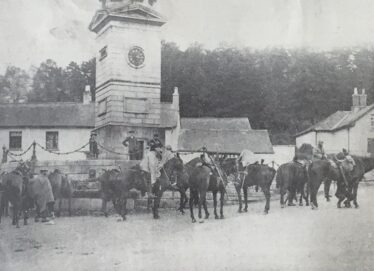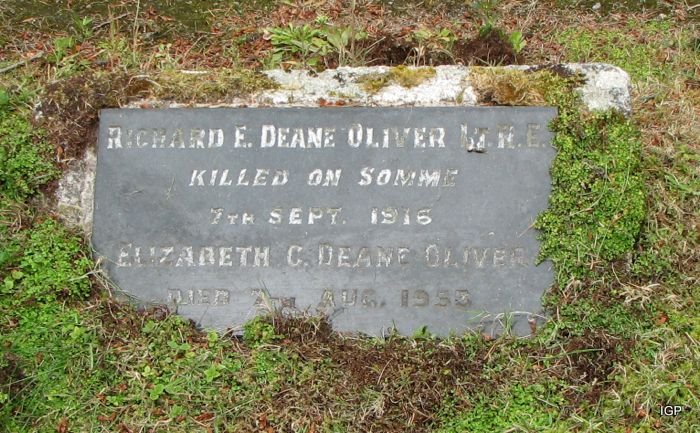Enniskerry 1919-1922 by Brian White


Eppels Film Ltd of Dublin in 1925 made the film “Irish Destiny” depicting the War of Independence. One of the locations used for the film is Enniskerry village. It shows a group of dancers in front of the clock tower in the village and a raid by a Black & Tan unit.
Curfew
The gathering of three or more persons was banned in Ireland. There was also a curfew between 10pm and 5am. This curbed the social life of people living in the village. Dance halls and public houses had to close early. The bus and rail companies had to re-arrange its timetable and all services ceased at 9.30 pm.
On 22nd May 1919 Alfred Anderson described as a “Sinn Féiner” from Sligo was arrested in Enniskerry and was returned to Sligo. A warrant for his arrest had been issued by the Sligo court for causing an unlawful assembly in Sligo.
Trenches
Locals in Enniskerry and district dug trenches in the road to halt military motor cavalcades. In order to get the implements to dig the trenches raids took place on road contractors, quarry tool sheds and on local farms. There are recorded incidents where the Military would round up a group of men to refill the trenches.

A cavalry patrol in the village of Enniskerry in Co. Wicklow. Irish Life magazine, 28 May 1920 – https://www.rte.ie/centuryireland/index.php/articles/flying-columns-of-british-soldiers-sent-to-quash-irelands-veiled-rebellion. Full collection available at the National Library of Ireland. Photo: By kind permission of the National Library of Ireland.
The above image shows a flying column on patrol in Enniskerry in 1920. The King Hussars were based in Rathmines Barracks and would patrol south County Dublin and North Wicklow. The patrol would commence in Rathmines and include Rathfarnham, the Glencree valley, Enniskerry and Bray.
Powerscourt
Lord Powerscourt allowed the Military to camp on his estate. When the Police barracks was destroyed by armed men on the 8th July 1922. Lord Powerscourt made available the Parish Hall as a temporary barracks. He also claimed compensation for the burned barracks.
In July 1921 two police constables were sitting in the coffee room of the Powerscourt Arms Hotel when shots rang out. One shot passed through the cap of a constable and grazed his forehead. Both constables returned fire but the person who fired the shots escaped unhurt.
Raids
In May 1921 a mail car was held up near Kilcroney. Interception of mail cars yielded cash, money orders. The rate of raids on mails cars caused some concern for the post office. In the period 1st January 1919 to 18th October 1920 a total of 741 raids on Mail Cars took place in Ireland.
Raids also took place on farms and hardware stores and items stolen included shotguns and ammunition, foodstuffs, clothing. Michael Tallon of Enniskerry had foodstuff stolen from his shop on 8th July 1922 the rebels also took his motor car. Abraham Chatterton who lived in the Powerscourt estate office on Kilgarron Hill had his car stolen on the 7th July 1922.
A number of farmers in the area had haycocks and sheds set on fire. These are put down to a couple of scenarios (1) the rebels wanted to destroy any evidence they were staying in the shed. (2) The military found that the shed was used by the rebels and then destroyed the barn. (3) the owner was passing information to the police or military. One will never know which scenario applied.
Lochners Pork Butchers of Bray were instructed to leave parcels of meat at the Silver Bridge on the Bray and Enniskerry Road. When Mr Lochner opened his shop a few days later he would find the payment for the goods left at the Silver Bridge.
In June 1922 a raid took place on Enniskerry Post Office. The post mistress Mrs Snow and her Assistant Miss Byrne were unhurt in the raid. The Raiders took £27 in cash and postal money orders. The cash box was found in Dalkey.
A second raid took place at the post office on 25th July 1922. Miss Byrne refused to give the raiders the keys and the raiders fled without any cash. In December 1922 the Postal Authorities gave Miss Byrne a merit cheque for showing bravery during the robbery of 25th July 1922.
An Enniskerry family: the Deane-Olivers
A great sadness came over the village on hearing of the death of Richard Edward Deane–Oliver (Royal Engineers). Killed in action on the Somme, September 7th, 1916, in his 26th Year. Richard was baptised in Powerscourt Church in 1890. His grandfather was Edward Falkoner Litton,QC., who at the time lived at Valclusa, Enniskerry.

Burial inscription of Richard Deane-Oliver 1916, St. Patricks, Enniskerry. Photo: Courtesy of http://www.igp-web.com
He was educated at Aravon, and Tinity College Dublin, where he graduated with a degree in Engineering. He gave up a responsible job on the Manchester Ship canal to take a commission in the Royal Engineers and was killed instantaneously by a sniper while engaged in constructing a new line of trenches. He is remembered on the Roll of Honour in the Christ Church Bray, and Aravon memorials, and on the family grave in Powerscourt Churchyard.
Losing Richard was only the beginning of the family’s troubles. His father, Charles Deane Oliver, lived Rockmills House,near Fermoy Co.Cork, was Chief Engineer of the Department of Agriculture , and the Congested Districts and Fisheries Board. He was responsible for a great many of the harbours in the south and west of Ireland, and for opening up Arklow harbour in 1915. In 1919, the year he retired, Rockmills House was attacked by masked men who shot Charles in both thighs. Then, in the spring of 1921, the IRA burnt Rockmills House down and the family, having lost everything except their lives, were forced to flee to England to live with relatives. They did return, however, to live productive lives in the new Republic.
(Charles Deane Oliver was born on 3 June 1861 and educated at St. Columba’s College, Dublin, and Trinity College, Dublin. He was the son of Richard Charles Deane Oliver and Katherine Hawtayne. He married Maria Charlotte Litton, daughter of Hon. Edward Falconer Litton, in 1888 and died on 6 February 1945 at age 83).
Children of Charles Deane Oliver and Maria Charlotte Litton:
1. Richard Edward Deane Oliver b. 21 Feb 1890, d. 7 Sep 1916
2. Elizabeth Catherine Deane Oliver b. 11 May 1895, d. 7 Aug 1953
3. Kathleen Maude Deane Oliver b. 15 Jan 1897
4. Silver Margaret Esther Deane Oliver b. 29 Jun 1899




Comments about this page
Interesting article. I think there was still a Chatterton estate agent in that house on Kilgarron in the 50s.
My family ran McGuirk’s Tearooms at Lough Bray. In the 50s, at a time when we all had hard kitchen chairs, a family down the valley had a sprung seat, obviously from a motor vehicle, in their chimney corner. The story was that it was the seat from a Tans’ Crossley Tender the IRA had stolen somewhere and torched at the gate to the lake, 100m from our house.
Did you ever come across any reference to this incident? I find it strange that there was never any mention of it in my family but you can’t imagine them not being interviewed about it. Perhaps we were toadies and didn’t come under suspicion.
Add a comment about this page